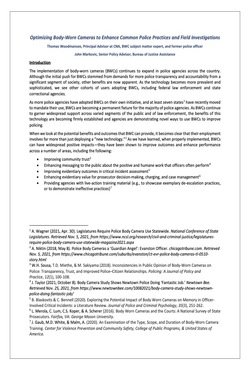Optimizing Body-Worn Cameras to Enhance Common Police Practices and Field Investigations
By Thomas Woodmansee, John Markovic
As more police agencies have adopted BWCs on their own initiative, and at least seven states have recently moved to mandate their use, BWCs are becoming a permanent fixture for the majority of police agencies. As BWCs continue to garner widespread support across varied segments of the public and of law enforcement, the benefits of this technology are becoming firmly established and agencies are demonstrating novel ways to use BWCs to improve policing. The context in which agencies implement BWCs is important, and police understand that BWCs are quickly becoming another component of the required “toolbelt” that they take into the field every day. Command staff now realize that BWCs are part of the fabric of their policing operations, i.e., BWCs are affected by and are affecting many other dimensions of policing. BWCs have, for instance, added to police workload by generating public and media requests for footage that must be painstakingly reviewed and redacted before release. On the positive side, departments have realized some areas where BWCs serve to streamline existing practices, such as the investigation and resolution of citizen complaints. At the same time agencies also recognize some previously unidentified and unintended benefits of this technology. BWCs provide police with opportunities to enhance their patrol responses and investigations. In this article written by CNA's Thomas Woodmansee and BJA's John Markovic, we discuss these two applications and other unique benefits of BWCs.
2022. 9p.


